Top 10
Under Stonehenge
By KATE RAVILIOUS
Monday, December 15, 2014
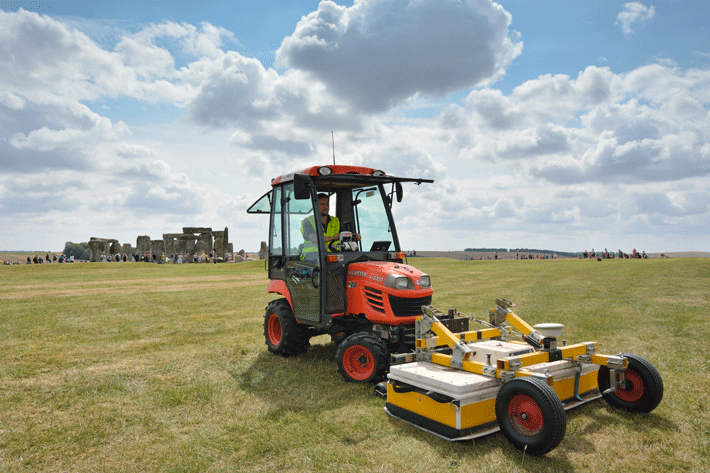
As if Stonehenge weren’t spectacular enough, an unprecedented digital survey—involving aerial laser scanning, ground-penetrating radar, and other geophysical and remote-sensing technologies—has revealed that the iconic 5,000-year-old standing stones were part of a much broader Neolithic ceremonial landscape. Unveiled at the British Science Festival in September, the research has revealed 17 new monuments and thousands of as-yet-uninterpreted archaeological features, including small shrines, burial mounds, and massive pits, across nearly five square miles of the Salisbury Plain.
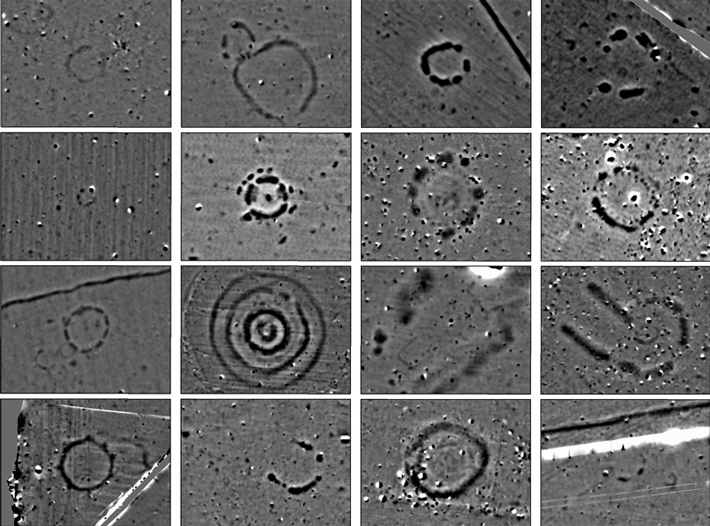 The research is also providing new insights into already documented features. For example, geophysical surveying of the “Cursus”—a two-mile-long mound north of Stonehenge—identified two massive pits that align astronomically with Stonehenge, in addition to a series of gaps in the mound. “The pits show how the Cursus, which was constructed 400 years earlier than Stonehenge, influenced the placement of the standing stones,” explains Vincent Gaffney of the University of Bradford. “We think that the gaps in the Cursus would have guided the movement of people as they processed to Stonehenge, contradicting the [previous] thinking that few people approached the standing stones.” Further, remote sensing at Durrington Walls—a mile-wide ritual monument close to Stonehenge—revealed that it used to be associated with up to 60 huge standing stones, some of which may now lie under earthen banks. “In the past we had this idea that Stonehenge was standing in splendid isolation, but it wasn’t,” says Gaffney. “It’s absolutely huge.”
The research is also providing new insights into already documented features. For example, geophysical surveying of the “Cursus”—a two-mile-long mound north of Stonehenge—identified two massive pits that align astronomically with Stonehenge, in addition to a series of gaps in the mound. “The pits show how the Cursus, which was constructed 400 years earlier than Stonehenge, influenced the placement of the standing stones,” explains Vincent Gaffney of the University of Bradford. “We think that the gaps in the Cursus would have guided the movement of people as they processed to Stonehenge, contradicting the [previous] thinking that few people approached the standing stones.” Further, remote sensing at Durrington Walls—a mile-wide ritual monument close to Stonehenge—revealed that it used to be associated with up to 60 huge standing stones, some of which may now lie under earthen banks. “In the past we had this idea that Stonehenge was standing in splendid isolation, but it wasn’t,” says Gaffney. “It’s absolutely huge.”
Seaton Down Hoard
By JASON URBANUS
Monday, December 15, 2014
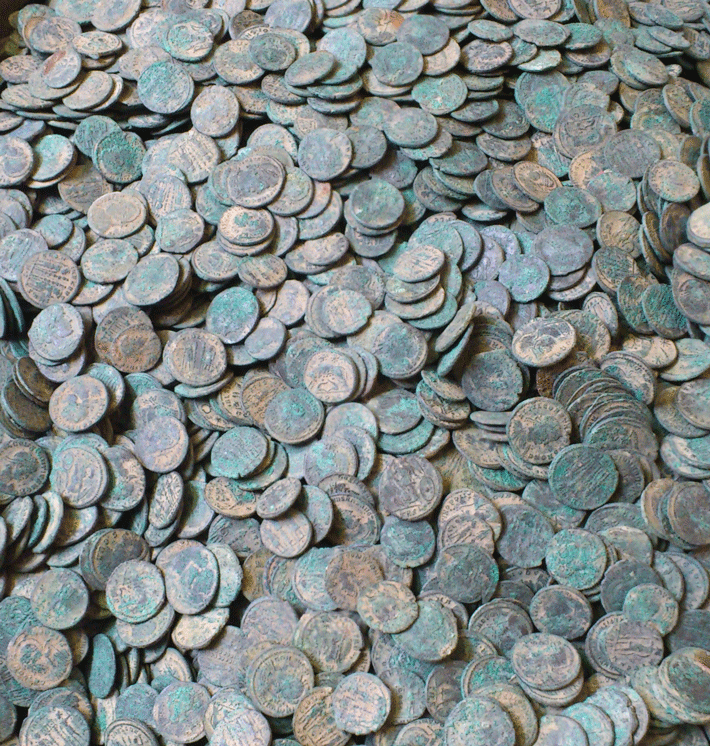 A metal detectorist in southwest England has discovered one of the largest Roman coin hoards ever found. The Seaton Down Hoard consists of 22,000 coins, dating from the A.D. 260s through the 340s. According to Vincent Drost, a British Museum numismatist researching the coins, the hoard may represent an individual’s private savings, a commercial transaction, or a soldier’s wages.
A metal detectorist in southwest England has discovered one of the largest Roman coin hoards ever found. The Seaton Down Hoard consists of 22,000 coins, dating from the A.D. 260s through the 340s. According to Vincent Drost, a British Museum numismatist researching the coins, the hoard may represent an individual’s private savings, a commercial transaction, or a soldier’s wages.
Despite the hoard’s remarkable size, it consists exclusively of low-valued copper alloy nummi, making the entire collection worth only the equivalent of a few gold solidi. Nonetheless, it will likely prove valuable to researchers. Archaeologists believe the Seaton Down Hoard was buried in the 340s, during the rule of co-emperors Constantius II and Constans. “A detailed study of the coins will provide important information on the features of Constantinian coinage and on coin use and supply in Britannia in the mid-fourth century,” says Drost.
Buddhism, in the Beginning
By SAMIR S. PATEL
Monday, December 15, 2014
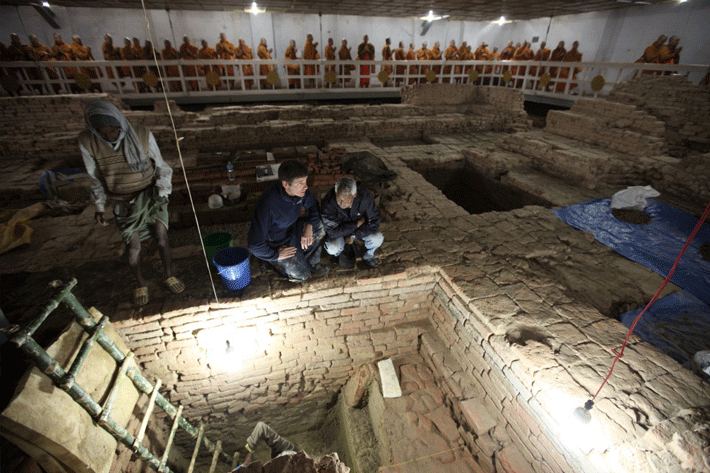
Excavations at Lumbini in Nepal have revealed never-before-understood details about the earliest years of Buddhism. According to tradition, Lumbini is where Maya Devi gave birth to Siddhartha Gautama, who became the venerated sage known as Buddha. Many ancient Buddhist shrines date to the third-century B.C. rule of Ashoka, a Mauryan Dynasty emperor who was key to the early spread of Buddhism. Under the remains of Mauryan temples at Lumbini (themselves topped by a succession of others), archaeologists uncovered evidence of an earlier timber structure upon which all the later temples were based. It dates to around the sixth century B.C., and the researchers, led by Robin Coningham of the University of Durham, believe this makes it the oldest Buddhist shrine in the world. This early date may also help inform the discussion of when Buddha lived. The excavation took place in the middle of an active shrine, with monks and pilgrims sometimes praying and chanting as the archaeologists worked below.
Greece's Biggest Tomb
By JARRETT A. LOBELL
Monday, December 15, 2014
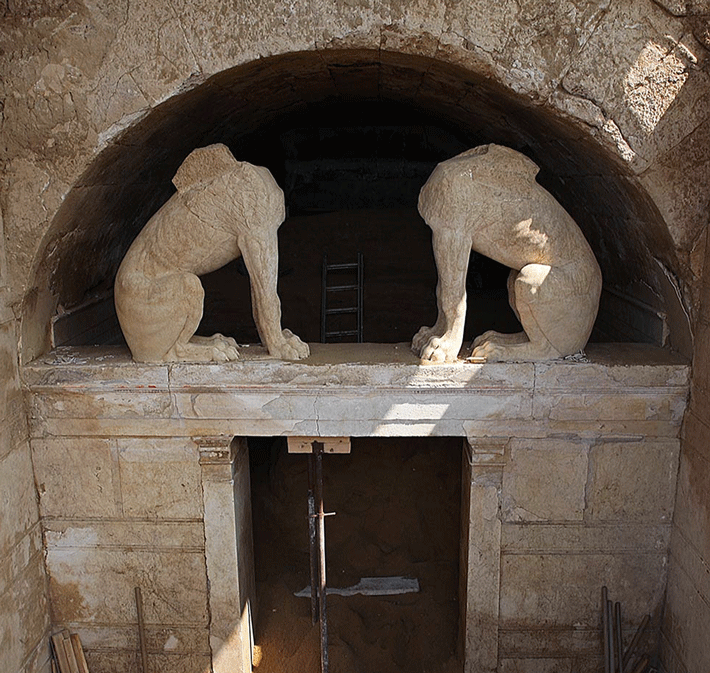
Four decades ago, after excavating hundreds of burials in the ancient Greek city of Amphipolis, about 60 miles north of Thessaloniki, Dimitris Lazaridis turned his attention to an enormous mound called the Hill of Kasta, which he believed contained a tomb or funerary monument of tremendous importance. Lazaridis’ work soon took him elsewhere, and archaeologists didn’t return to Kasta until 2012, when they began to expose the 1,500 feet of marble and limestone walls encircling the mound. This past summer the team found the entrance to the extraordinary monument Lazaridis suspected was there from the start. Work at the site is ongoing, but thus far archaeologists have uncovered a large entranceway guarded by marble sphinxes and three separate chambers. The first is paved with white marble and contains a pair of caryatids standing 10 feet high. The second chamber’s floor is covered with a mosaic of the god Pluto abducting Persephone. And the third, entered through a four-foot-wide marble door, is filled with more sculpture. The tomb dates to the last quarter of the fourth century B.C., when Amphipolis was an important city under Greece’s Macedonian rulers.
Decoding Neanderthal Genetics
By DANIEL WEISS
Monday, December 15, 2014
The first draft of the sequence of the Neanderthal genome was published in 2010 (“Neanderthal Genome Decoded,” July/August 2010). One might think that it would tell us everything we need to know about the genetic differences between modern humans and our closest evolutionary cousins. But it turns out the raw genetic code is only half the story. Just as important is epigenetics—features of the genome that determine which genes are active and which are inactive, factors that can in turn have a dramatic effect on one’s traits.
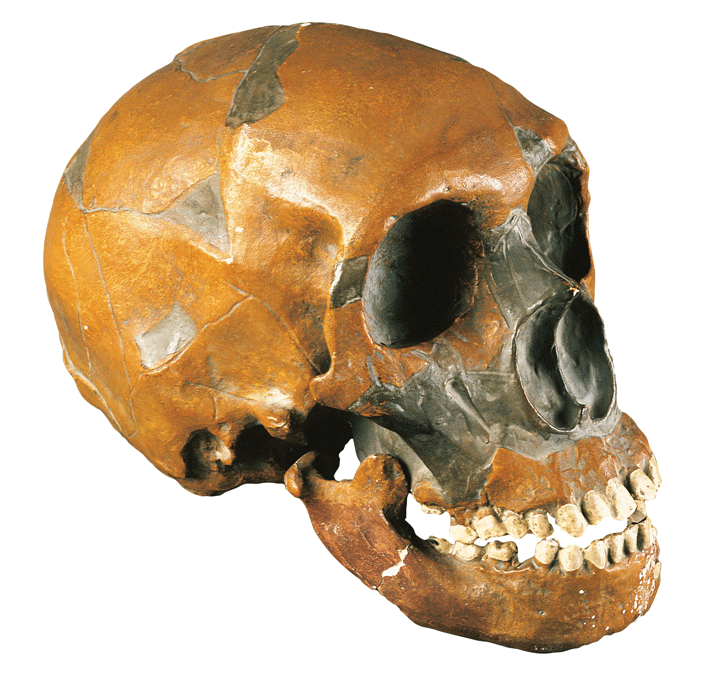 Now, researchers from Hebrew University in Jerusalem and the Max Planck Institute for Evolutionary Anthropology, where the original sequencing took place, have found an ingenious way to investigate Neanderthal epigenetics. Their findings have provided tantalizing clues to how the bodies and brains of modern humans have evolved since splitting from Neanderthals several hundred thousand years ago. The usual methods for determining whether genes are active or inactive are highly destructive and cannot be used on scarce Neanderthal genetic material. Instead, the researchers managed to detect telltale epigenetic signs in the Neanderthal genome based on the insight that certain portions of ancient DNA tend to be misread in a distinctive way by DNA sequencers.
Now, researchers from Hebrew University in Jerusalem and the Max Planck Institute for Evolutionary Anthropology, where the original sequencing took place, have found an ingenious way to investigate Neanderthal epigenetics. Their findings have provided tantalizing clues to how the bodies and brains of modern humans have evolved since splitting from Neanderthals several hundred thousand years ago. The usual methods for determining whether genes are active or inactive are highly destructive and cannot be used on scarce Neanderthal genetic material. Instead, the researchers managed to detect telltale epigenetic signs in the Neanderthal genome based on the insight that certain portions of ancient DNA tend to be misread in a distinctive way by DNA sequencers.
This reading of Neanderthal epigenetics produced a number of novel results. Two genes involved in determining body shape turned out to be highly inactivated in Neanderthals and highly activated in humans. This could help explain why Neanderthals have thicker hands, wider knee and elbow joints, and shorter limbs. “These genes are identical between us and Neanderthals,” says Liran Carmel of Hebrew University. “So we are convinced we have found a region where only the epigenetics is different.”
Many genes associated with diseases—in particular psychiatric and neurological disorders such as Alzheimer’s disease, autism, and schizophrenia—also appear to be activated in modern humans but not Neanderthals. Carmel says the activation of these genes may have produced an evolutionary catch-22: bestowing a benefit, perhaps by changing the wiring of our brains, but also introducing an increased risk of disease.
Advertisement
Advertisement
IN THIS ISSUE
Advertisement

Recent Issues
-
 May/June 2024
May/June 2024
-
 March/April 2024
March/April 2024
-
 January/February 2024
January/February 2024
-
 November/December 2023
November/December 2023
-
 September/October 2023
September/October 2023
-
 July/August 2023
July/August 2023
-
 May/June 2023
May/June 2023
-
 March/April 2023
March/April 2023
-
 January/February 2023
January/February 2023
-
 November/December 2022
November/December 2022
-
 September/October 2022
September/October 2022
-
 July/August 2022
July/August 2022
-
 May/June 2022
May/June 2022
-
 March/April 2022
March/April 2022
-
 January/February 2022
January/February 2022
-
 November/December 2021
November/December 2021
-
 September/October 2021
September/October 2021
-
 July/August 2021
July/August 2021
-
 May/June 2021
May/June 2021
-
 March/April 2021
March/April 2021
-
 January/February 2021
January/February 2021
-
 November/December 2020
November/December 2020
-
 September/October 2020
September/October 2020
-
 July/August 2020
July/August 2020
-
 May/June 2020
May/June 2020
-
 March/April 2020
March/April 2020
-
 January/February 2020
January/February 2020
-
 November/December 2019
November/December 2019
-
 September/October 2019
September/October 2019
-
 July/August 2019
July/August 2019
-
 May/June 2019
May/June 2019
-
 March/April 2019
March/April 2019
-
 January/February 2019
January/February 2019
-
 November/December 2018
November/December 2018
-
 September/October 2018
September/October 2018
-
 July/August 2018
July/August 2018
-
 May/June 2018
May/June 2018
-
 March/April 2018
March/April 2018
-
 January/February 2018
January/February 2018
-
 November/December 2017
November/December 2017
-
 September/October 2017
September/October 2017
-
 July/August 2017
July/August 2017
-
 May/June 2017
May/June 2017
-
 March/April 2017
March/April 2017
-
 January/February 2017
January/February 2017
-
 November/December 2016
November/December 2016
-
 September/October 2016
September/October 2016
-
 July/August 2016
July/August 2016
-
 May/June 2016
May/June 2016
-
 March/April 2016
March/April 2016
-
 January/February 2016
January/February 2016
-
 November/December 2015
November/December 2015
-
 September/October 2015
September/October 2015
-
 July/August 2015
July/August 2015
-
 May/June 2015
May/June 2015
-
 March/April 2015
March/April 2015
-
 January/February 2015
January/February 2015
-
 November/December 2014
November/December 2014
-
 September/October 2014
September/October 2014
-
 July/August 2014
July/August 2014
-
 May/June 2014
May/June 2014
-
 March/April 2014
March/April 2014
-
 January/February 2014
January/February 2014
-
 November/December 2013
November/December 2013
-
 September/October 2013
September/October 2013
-
 July/August 2013
July/August 2013
-
 May/June 2013
May/June 2013
-
 March/April 2013
March/April 2013
-
 January/February 2013
January/February 2013
-
 November/December 2012
November/December 2012
-
 September/October 2012
September/October 2012
-
 July/August 2012
July/August 2012
-
 May/June 2012
May/June 2012
-
 March/April 2012
March/April 2012
-
 January/February 2012
January/February 2012
-
 November/December 2011
November/December 2011
-
 September/October 2011
September/October 2011
-
 July/August 2011
July/August 2011
-
 May/June 2011
May/June 2011
-
 March/April 2011
March/April 2011
-
 January/February 2011
January/February 2011
Advertisement






